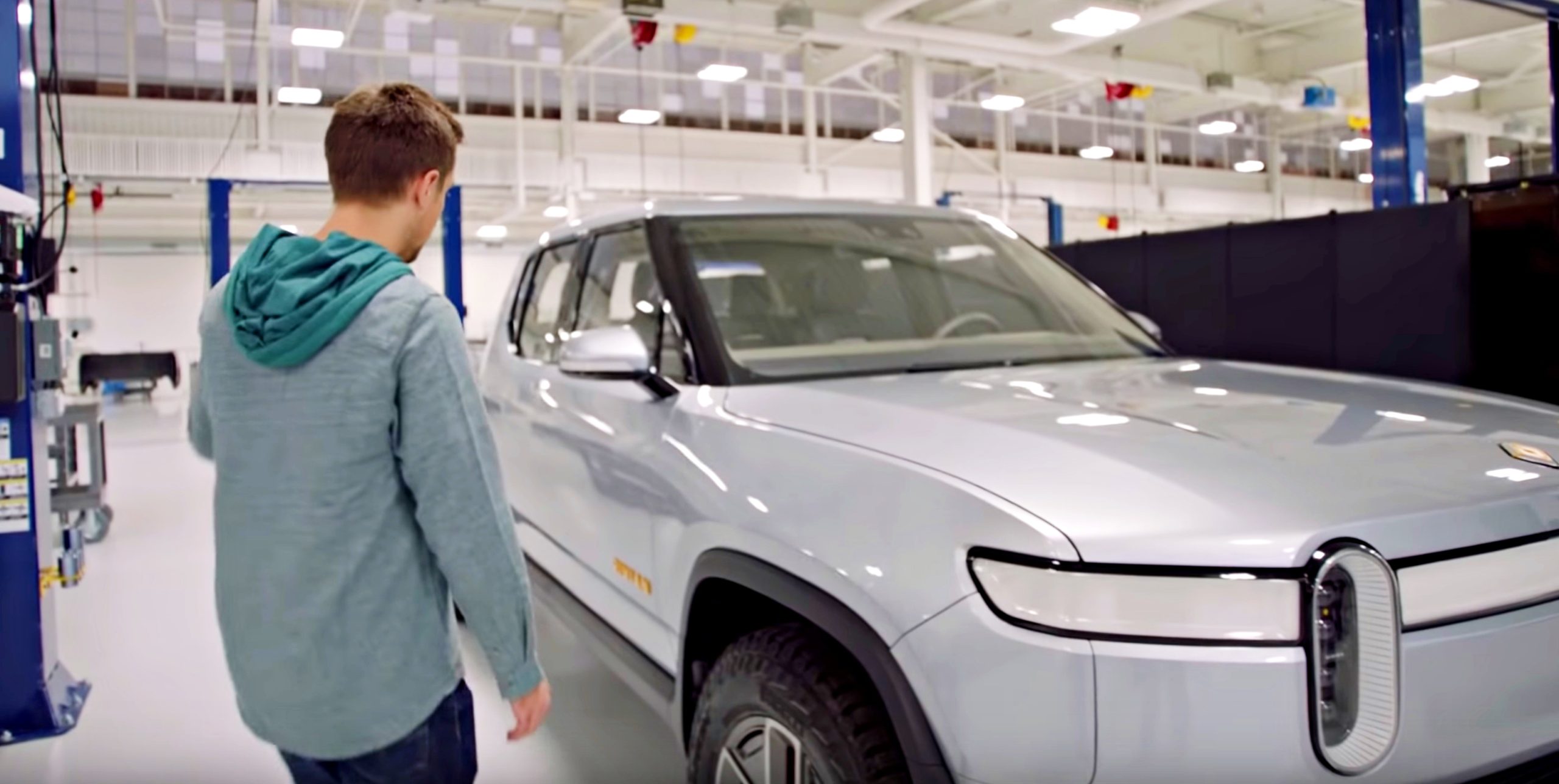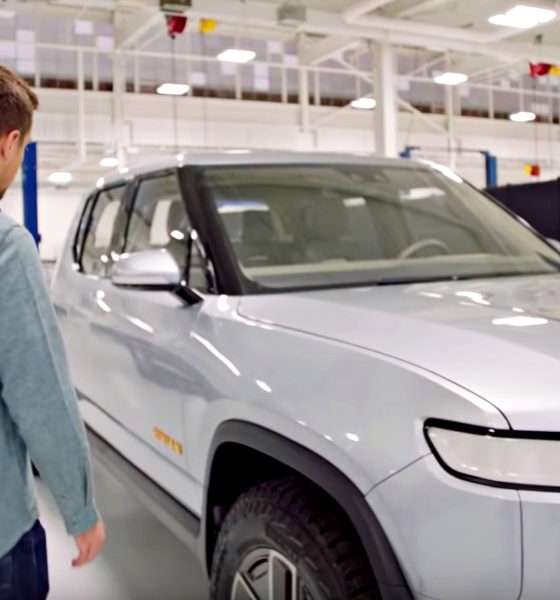

News
Rivian set to debut energy storage project using ‘second life’ batteries from vehicles
Rivian Automotive and the Honnold Foundation are working together in an initiative that is set to use the electric truck maker’s “second-life” batteries as stationary energy storage units in a microgrid project at Adjuntas, Puerto Rico. This marks a huge step for Rivian, which is planning on expanding its reach beyond the manufacture of all-electric luxury adventure vehicles.
Rivian will be utilizing 135 kWh battery packs from its development vehicles for the upcoming energy storage project, which is expected to launch in 2020. The company has designed its battery packs and modules in such a way that they can be easily transitioned from vehicle energy storage to stationary energy storage at the end of their vehicle life. The Rivian CEO described the concept in a press release.
“Second-life batteries are a big enabler to accelerating widespread adoption of renewable energy, and it’s exciting to envision this system contributing importantly to a community. This project allows us to model a customized energy storage solution that takes into account space constraints, disaster resiliency, and energy independence,” Scaringe said.
Using older batteries for energy storage is a clever way for Rivian to recycle the cells it uses for its all-electric trucks. While batteries at the end of their vehicle life will likely show some wear compared to those used in new EVs, they could still function well as stationary energy storage units. After all, optimal batteries for electric trucks require a lot of power, but those energy storage units could make do with much less (propelling the R1T from 0-60 mph, for example, takes a lot of power, but turning on the lights in a household does not require as much).
Rivian and the Honnold Foundation selected Adjuntas, Puerto Rico as the site of their microgrid project partly due to the town being in need of help. Adjuntas was struck by Hurricane Maria in 2017, and the community has been struggling with power since. If successful, Rivian and Honnold’s microgrid initiative could help many of the businesses located near the town’s main square. Residents could also have backup power in the event that power shortages happen.
Further details of the project will be discussed by RJ Scaringe and elite climber Alex Honnold at Denver, CO on June 15 in a livestreamed event, which could be accessed here.
The full press release for Rivian and the Honnold Foundation’s upcoming microgrid project could be accessed below.
DENVER, June 13, 2019 /PRNewswire/ — On June 15, electric adventure vehicle maker Rivian is announcing a project to use its second-life batteries in a solar microgrid initiative with the Honnold Foundation. The goal: to support energy independence and adoption of renewable power generation. The project, in the town of Adjuntas, Puerto Rico, marks Rivian’s first steps in its broad plan to utilize second-life batteries for a wide variety of applications.
Rivian CEO RJ Scaringe and elite climber Alex Honnold will discuss the project in Denver, Colorado on June 15 at 6PM MT. The conversation will be moderated by endurance athlete and podcaster Rich Roll. The livestream can be found here: https://www.youtube.com/c/RivianOfficial/live
The company is using 135kWh battery packs from its development vehicles to support the project.
Rivian has designed its pack, module, and battery management system to seamlessly transition from vehicle energy storage to stationary energy storage at the end of their vehicle life. The battery module’s thin design enables second-life applications that are space-efficient and customizable, important for environments with existing infrastructure.
“Second-life batteries are a big enabler to accelerating widespread adoption of renewable energy, and it’s exciting to envision this system contributing importantly to a community. This project allows us to model a customized energy storage solution that takes into account space constraints, disaster resiliency and energy independence,” said Scaringe.
Adjuntas is a city of 20,000 in midwestern Puerto Rico. It was severely impacted by Hurricane Maria in 2017, and with climate change increasing the frequency and severity of storms, Adjuntas NGO Casa Pueblo has sought to collaborate on rugged, affordable sources of community power.
The Honnold Foundation and Rivian battery engineers visited Casa Pueblo earlier in 2019 to meet with community leaders and together are designing a site-specific system that will power many of the businesses located in the Adjuntas town square. In power loss scenarios, the downtown solar microgrid will allow Adjuntas residents access to electricity for core businesses. By offsetting day-to-day electric bills, the system also brings down high commercial energy costs, which in Puerto Rico are twice the national average.
The system is expected to launch in 2020.

Elon Musk
Elon Musk and Tesla AI Director share insights after empty driver seat Robotaxi rides
The executives’ unoccupied tests hint at the rapid progress of Tesla’s unsupervised Robotaxi efforts.

Tesla CEO Elon Musk and AI Director Ashok Elluswamy celebrated Christmas Eve by sharing personal experiences with Robotaxi vehicles that had no safety monitor or occupant in the driver’s seat. Musk described the system’s “perfect driving” around Austin, while Elluswamy posted video from the back seat, calling it “an amazing experience.”
The executives’ unoccupied tests hint at the rapid progress of Tesla’s unsupervised Robotaxi efforts.
Elon and Ashok’s firsthand Robotaxi insights
Prior to Musk and the Tesla AI Director’s posts, sightings of unmanned Teslas navigating public roads were widely shared on social media. One such vehicle was spotted in Austin, Texas, which Elon Musk acknowleged by stating that “Testing is underway with no occupants in the car.”
Based on his Christmas Eve post, Musk seemed to have tested an unmanned Tesla himself. “A Tesla with no safety monitor in the car and me sitting in the passenger seat took me all around Austin on Sunday with perfect driving,” Musk wrote in his post.
Elluswamy responded with a 2-minute video showing himself in the rear of an unmanned Tesla. The video featured the vehicle’s empty front seats, as well as its smooth handling through real-world traffic. He captioned his video with the words, “It’s an amazing experience!”
Towards Unsupervised operations
During an xAI Hackathon earlier this month, Elon Musk mentioned that Tesla owed be removing Safety Monitors from its Robotaxis in Austin in just three weeks. “Unsupervised is pretty much solved at this point. So there will be Tesla Robotaxis operating in Austin with no one in them. Not even anyone in the passenger seat in about three weeks,” he said. Musk echoed similar estimates at the 2025 Annual Shareholder Meeting and the Q3 2025 earnings call.
Considering the insights that were posted Musk and Elluswamy, it does appear that Tesla is working hard towards operating its Robotaxis with no safety monitors. This is quite impressive considering that the service was launched just earlier this year.
Elon Musk
Starlink passes 9 million active customers just weeks after hitting 8 million
The milestone highlights the accelerating growth of Starlink, which has now been adding over 20,000 new users per day.

SpaceX’s Starlink satellite internet service has continued its rapid global expansion, surpassing 9 million active customers just weeks after crossing the 8 million mark.
The milestone highlights the accelerating growth of Starlink, which has now been adding over 20,000 new users per day.
9 million customers
In a post on X, SpaceX stated that Starlink now serves over 9 million active users across 155 countries, territories, and markets. The company reached 8 million customers in early November, meaning it added roughly 1 million subscribers in under seven weeks, or about 21,275 new users on average per day.
“Starlink is connecting more than 9M active customers with high-speed internet across 155 countries, territories, and many other markets,” Starlink wrote in a post on its official X account. SpaceX President Gwynne Shotwell also celebrated the milestone on X. “A huge thank you to all of our customers and congrats to the Starlink team for such an incredible product,” she wrote.
That growth rate reflects both rising demand for broadband in underserved regions and Starlink’s expanding satellite constellation, which now includes more than 9,000 low-Earth-orbit satellites designed to deliver high-speed, low-latency internet worldwide.
Starlink’s momentum
Starlink’s momentum has been building up. SpaceX reported 4.6 million Starlink customers in December 2024, followed by 7 million by August 2025, and 8 million customers in November. Independent data also suggests Starlink usage is rising sharply, with Cloudflare reporting that global web traffic from Starlink users more than doubled in 2025, as noted in an Insider report.
Starlink’s momentum is increasingly tied to SpaceX’s broader financial outlook. Elon Musk has said the satellite network is “by far” the company’s largest revenue driver, and reports suggest SpaceX may be positioning itself for an initial public offering as soon as next year, with valuations estimated as high as $1.5 trillion. Musk has also suggested in the past that Starlink could have its own IPO in the future.
News
NVIDIA Director of Robotics: Tesla FSD v14 is the first AI to pass the “Physical Turing Test”
After testing FSD v14, Fan stated that his experience with FSD felt magical at first, but it soon started to feel like a routine.

NVIDIA Director of Robotics Jim Fan has praised Tesla’s Full Self-Driving (Supervised) v14 as the first AI to pass what he described as a “Physical Turing Test.”
After testing FSD v14, Fan stated that his experience with FSD felt magical at first, but it soon started to feel like a routine. And just like smartphones today, removing it now would “actively hurt.”
Jim Fan’s hands-on FSD v14 impressions
Fan, a leading researcher in embodied AI who is currently solving Physical AI at NVIDIA and spearheading the company’s Project GR00T initiative, noted that he actually was late to the Tesla game. He was, however, one of the first to try out FSD v14.
“I was very late to own a Tesla but among the earliest to try out FSD v14. It’s perhaps the first time I experience an AI that passes the Physical Turing Test: after a long day at work, you press a button, lay back, and couldn’t tell if a neural net or a human drove you home,” Fan wrote in a post on X.
Fan added: “Despite knowing exactly how robot learning works, I still find it magical watching the steering wheel turn by itself. First it feels surreal, next it becomes routine. Then, like the smartphone, taking it away actively hurts. This is how humanity gets rewired and glued to god-like technologies.”
The Physical Turing Test
The original Turing Test was conceived by Alan Turing in 1950, and it was aimed at determining if a machine could exhibit behavior that is equivalent to or indistinguishable from a human. By focusing on text-based conversations, the original Turing Test set a high bar for natural language processing and machine learning.
This test has been passed by today’s large language models. However, the capability to converse in a humanlike manner is a completely different challenge from performing real-world problem-solving or physical interactions. Thus, Fan introduced the Physical Turing Test, which challenges AI systems to demonstrate intelligence through physical actions.
Based on Fan’s comments, Tesla has demonstrated these intelligent physical actions with FSD v14. Elon Musk agreed with the NVIDIA executive, stating in a post on X that with FSD v14, “you can sense the sentience maturing.” Musk also praised Tesla AI, calling it the best “real-world AI” today.








